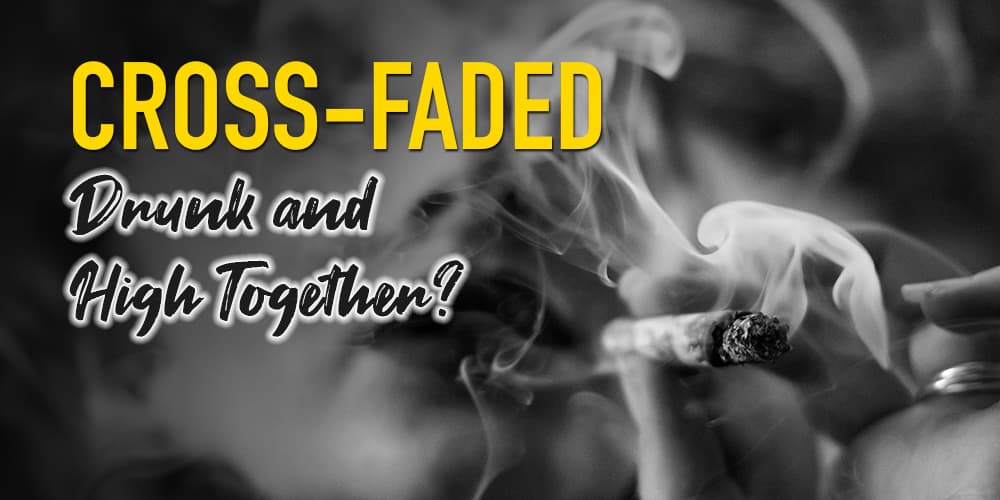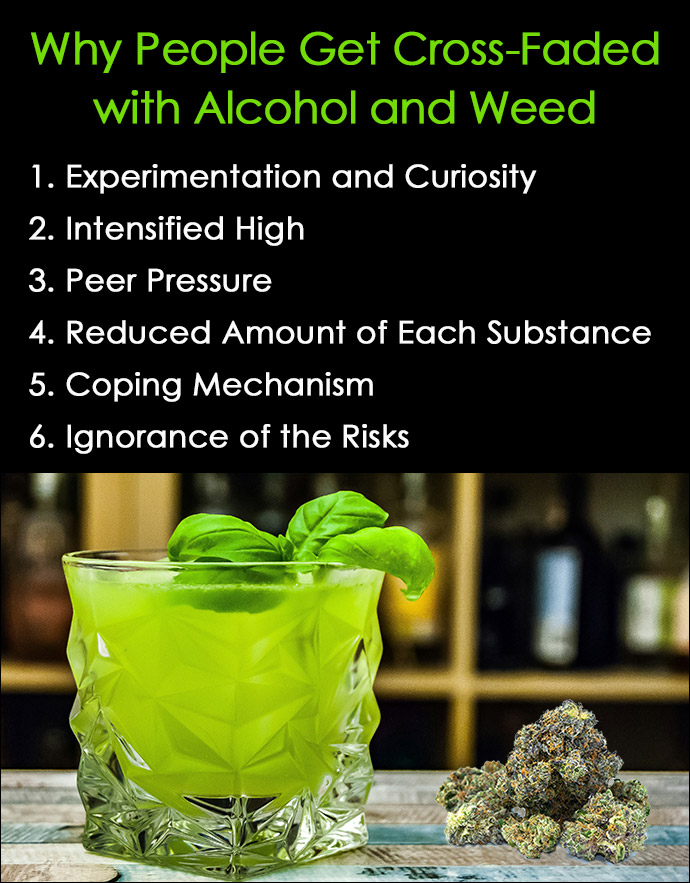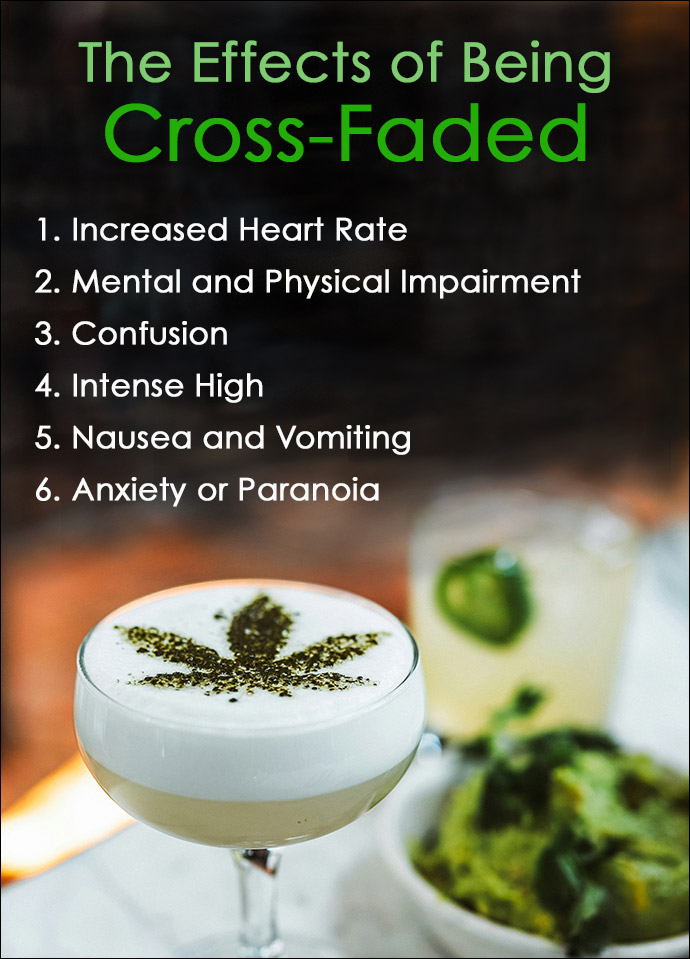
People might not be familiar with the term or meaning of “cross-faded” although many have experienced the crossfading effects of being drunk and high at the same time from alcohol and marijuana.
There are different reasons why people would use alcohol and weed together. Some consciously use them at the same time on purpose, while others cross fade accidentally.
Whatever the reason, it’s important to understand the cross-faded effects on the brain, and the potential dangers and risks of using multiple substances simultaneously.
What is the Meaning of Cross-Faded?
Cross-Faded means to experience the feeling of being drunk and high at the same time from drinking alcohol and smoking weed or consuming marijuana edibles.
Crossfading creates a synergistic effect that combines the feelings of being intoxicated from alcohol and the high from cannabis.
Alcohol is considered a depressant that induces intoxication and has an impact on various regions of the brain and central nervous system.
The THC in marijuana stimulates cannabinoid receptors in other areas of the brain and produces a high or feeling that differs from alcohol.
When the two are consumed together, the effect is different than using each substance alone by itself.
People have been using these two substances together for a long time, though teens and young adults have recently given it the name cross-faded either to fit in with peers or hide this form of getting high from adults.
Being cross-faded can occur from using many different types of substances at the same time, even though the term most commonly refers to feeling drunk and high at the same time from alcohol and marijuana.
It is similar to polysubstance abuse from using three or more substances at the same time.
In a recent study of young adults between the ages of 18 and 23 years old, 87% had heard of the term “cross-faded,” and 43% considered it to be the effects of using alcohol and marijuana together.
Why Do People Get Cross-Faded?
Some people enjoy the feeling of being cross faded, yet others may experience it accidentally.
Despite the possible dangers and risks, every person is different and so are the reasons for using alcohol and weed together.

Reasons for Crossfading Alcohol and Weed
1. Experimentation and Curiosity
Most teens and young adults don’t have many years of experience using drugs and alcohol, so they are curious about trying new ways to get high. If they like the feeling of one substance, they may be eager to experiment with others, and often don’t have a fear of trying new things.
2. Amplified Affects and Intensified High
Using weed and alcohol together amplifies the effects of each substance and produces an intensified high from cross-fading that can’t be obtained by using only one or the other by itself.
3. Peer Pressure
It’s common for teens and young adults to fall prey to the peer pressure of using drugs or alcohol. Being socially accepted by others is often more important than the risks of using different substances at the same time.
4. Reduced Amount of Each Substance
Because using alcohol and weed together amplifies the effects, some people rationalize they can do less of each one, and still get the same high. This gives the false perception that using less is more, and they think it may be safer and less dangerous.
5. Coping Mechanism
Not everyone who uses drugs or alcohol does it simply to get high. Some people use them as a coping mechanism to find relief from anxiety, depression, and other mental health issues.
Over time, people build a tolerance to most substances, and they don’t feel the same effect as when they started using them.
Getting cross-faded is a way to combine marijuana and alcohol to deal with the stress or pain instead of increasing the amount of alcohol or marijuana alone.
6. Ignorance of the Risks
People who are either starting out and experimenting with crossfading, or others who have been doing it for a long time might not understand the dangers of mixing multiple substances at the same time.
Getting cross-faded might appear to be harmless so their ignorance of the risks leads them to continue doing it.
What Are the Effects of Being Cross-Faded?
Alcohol and marijuana each produce their own physical and psychological effects when taken alone without other substances.
The physical effects may include increased heart rate, sweating, nausea or vomiting.
The psychological symptoms can be positive feelings of euphoria and relaxation or negative ones that cause anxiety and paranoia.
The effects are usually amplified when drinking and getting high with marijuana at the same time, similar to greening out, or they may experience entirely different cross-faded symptoms.
These effects will vary for each person depending on a number of factors such as the amount of each one taken, a person’s tolerance to each substance, and whether marijuana was smoked or eaten.

Effects of Crossfading Can Include:
1. Increased Heart Rate and Blood Pressure
When using marijuana or alcohol, each one can increase heart rate as well as blood pressure. When using them both together, it’s possible it will elevate them even more.
2. Mental and Physical Impairment
Cross-fading can reduce reaction times, impair judgment and decision-making abilities, decrease coordination, and impede motor skills. These are common side effects of each substance, but they are intensified when used together.
3. Confusion
Being cognitively impaired can cause confusion, disorientation, and alter the ability to focus or concentrate.
4. Intense High
Being cross-faded from alcohol and marijuana together produces a much more intense high than just using one of the substances by itself. The high can either be amplified or blend together several elements of each substance to intensify the overall feelings.
5. Nausea and Vomiting
Combining the depressant nature of alcohol with the psychoactive ingredient THC in marijuana can cause a person to become dizzy and lead to nausea or vomiting. This resembles alcohol poisoning symptoms the next day after a night of heavy drinking.
6. Anxiety or Paranoia
Alcohol by itself can be calming, but when combined with weed, it can boost the anxiety and paranoia effects of marijuana, making them worse than only using the drug alone.
Alcohol by itself can produce hangover anxiety symptoms, but these can become even worse when mixed with weed.
How Long Does Being Cross-Faded Last?
Much like the cross-faded effects, the duration of the experience will also depend on several variables.
The length of time it lasts will vary for each person based on:
- Amount of each substance consumed
- Metabolism
- Tolerance to each substance
- THC potency
- Method of THC ingestion (smoked vs eaten)
- Amount of food in the system
In general, cross-faded feelings will usually last for a few hours after a person stops using both substances. If they continue to drink alcohol and ingest marijuana, the feelings may be present for 2 to 8 hours after they stop using them.
The high from drinking alcohol and smoking marijuana often appears within 15 minutes to an hour after first using them.
Alcohol is metabolized at the rate of one drink per hour.
The high from smoking weed will last anywhere from one to three hours depending on the potency and a person’s tolerance.
When eating cannabis edibles, the timeline can change dramatically. It may take one to several hours to feel the initial effects, and the high can last up to 8 hours.
Even experience pot smokers who have a tolerance can feel very different effects when eating THC and notice the duration is much longer.
Dab wax is a very potent marijuana concentrate that causes an intense high, and using it with alcohol will be much different than smoking a lower-potency strain.
The amount, potency, and method of ingestion all play a vital role in the cross-faded duration. It’s important for people to know this is why each experience can vary greatly.
Even though the term cross-faded is a rather new one, people have been using alcohol and marijuana together at the same time for as long as people have been getting high.
Crossfading may appear to be a novel and interesting way to get high, but it does come with risks including unsafe behavior, health issues, psychological dependence, and addiction.
If substance use spirals out of control, it’s important to seek help or treatment before things get too bad.
Frequently Asked Questions
What are the Dangers and Health Risks of Being Cross-Faded?
Combining multiple substances to get high compounds the effects of each one and can be more dangerous than only using one.
Some of the most common cross-faded dangers and risks include:
- Increased number of accidents and injuries
- Mental health issues like anxiety, depression, and panic attacks
- Hangover symptoms or alcohol poisoning
- Substance dependance or addiction
- Heart and blood pressure issues
- DUI and legal consequences
- Dehydration
What Other Substances Do People Use to Get Cross-Faded?
Alcohol and marijuana is the most common combination of substances people use to get cross-faded.
However, alcohol is one of the most commonly used substances overall, in part because it is socially accepted and legal for anyone old enough to purchase it.
Because so many people drink alcohol, they will use almost any other type of substance to amplify the feelings of drinking. This includes legal prescription medications such opioids, Adderall, and Xanax, to illegal ones like cocaine and heroin.
How Do the Cross-Faded Risks Compare to Single Substance Use?
Obviously, using only one substance at a time is much safer and less risky than being cross-faded from mixing multiple substances.
Mixing substances intensifies the high but also the impairment, which can lead to more accidents and riskier behavior. This can increase the chances of getting into an accident or being pulled over for a driving under the influence (DUI) arrest.
In addition, the unhealthy symptoms of nausea, vomiting, and anxiety are enhanced when an individual is cross-faded.
How Does Combining Alcohol and Marijuana Affect the Brain and Body Differently Than Other Substances?
Most substances have a unique psychoactive effect based on the receptors in the brain they attach to.
Alcohol is a central nervous system depressant that lowers inhibitions and impairs speech and coordination.
The THC in marijuana attaches to cannabinoid receptors in the brain that cause euphoria and distortions of perception. When mixed with alcohol, it can amplify THC levels and boost the effects of each substance.
Opioids are a central nervous system depressant like alcohol. Bothe substances can cause cognitive impairment and reduce respiratory function, so using them together boosts the depressant qualities of each. This can be dangerous and may lead to respiratory arrest.
Cocaine is a stimulant that by itself increases energy, mood, heart rate, and blood pressure. But when cocaine is cross-faded with alcohol, it produces a metabolite known as cocaethylene that intensifies the stimulating effects. This can induce thoughts of rage, anger, and unhealthy behavior.
Related Posts
- Dry Drunk Syndrome and What is a Dry Drunk?
The term Dry Drunk Syndrome, or simply Dry Drunk, refers to a person who quit…
- Alcohol Blackout Drunk Causes, Dangers, Prevention
Ever been blackout drunk or had an alcohol blackout? That is, have your memories after…
- What is a High Functioning Alcoholic?
It’s easier than people think to develop an alcohol use disorder (AUD) or become a…
